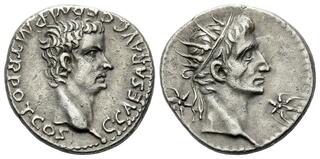| Naville Numismatics Ltd. > Auction 86 | Auction date: 17 December 2023 |
| Lot number: 431 Price realized: 6,050 GBP (Approx. 7,683 USD / 7,038 EUR) Note: Prices do not include buyer's fees. | Show similar lots on CoinArchives Find similar lots in upcoming auctions on |
| Lot description: Gaius, 37-41 Denarius Lugdunum circa 37-38, AR 18.00 mm., 3.67 g. C CAESAR AVG GERM P M TR POT COS Bare head of Gaius r. Rev. Radiate head of Augustus r., between two stars. C 11. BMC 4. RIC 2. CBN 3. Very rare. Nicely toned, two lovely portraits , well struck on a sound metal, Extrtemely Fine. Few of Rome's emperors enjoy as foul a reputation as Gaius, who is generally known by the nickname Caligula, meaning 'bootikin' or 'little boots', which he received from his father's soldiers while he was still an amiable child. He grew to despise the nickname almost as much as everyone grew to despise him. There is little need to revisit the list of his debaucheries, incests and acts of depravity – we need only note that his behaviour was a special blend of intellect and insanity, and that he has few peers beyond Nero, Commodus and Elagabalus. On the bright side, Caligula was dutiful when it came to his well-produced coinage. Caligula honoured his great-grandfather Augustus, very likely Tiberius (see below), his murdered parents, Germanicus and Agrippina Senior, and his murdered brothers, Nero Caesar and Drusus Caesar. Among the living he honoured his three sisters – in whom he had more than a casual interest – and, on provincial coinage, his final wife Caesonia and their daughter Drusilla Minor, both of whom were murdered within an hour of Caligula. This denarius belongs to an issue that is far more mysterious than generally known. It is attributed to Lugdunum, where Caligula may have struck only gold and silver during his inaugural year, and where the radiate portrait comes in two varieties: 1) without inscription and flanked by two stars (the type offered here), 2) without stars and with the inscription DIVVS AVG PATER PATRIAE (all issues attributed to Rome are of this second type). This duality invites us to speculate that the radiate portrait on the anepigraphic type offered here is actually Tiberius, and that the two stars represent Augustus and Julius Caesar – the only two men who had been deified. This becomes all the more likely if we consider that Caligula made an initial request for Tiberius' deification, but he dropped the matter not long after he returned to Rome and learned at first hand how poor the public sentiment was for Tiberius. Along with his change of heart, Caligula may have abandoned the anepigraphic type in favour of the issue that explicitly identifies the radiate head as Divus Augustus, which he continued to strike each and every year to the end of his reign. Few of Rome's emperors enjoy as foul a reputation as Gaius, who is generally known by the nickname Caligula, meaning 'bootikin' or 'little boots', which he received from his father's soldiers while he was still an amiable child. He grew to despise the nickname almost as much as everyone grew to despise him. There is little need to revisit the list of his debaucheries, incests and acts of depravity – we need only note that his behaviour was a special blend of intellect and insanity, and that he has few peers beyond Nero, Commodus and Elagabalus. On the bright side, Caligula was dutiful when it came to his well-produced coinage. Caligula honoured his great-grandfather Augustus, very likely Tiberius (see below), his murdered parents, Germanicus and Agrippina Senior, and his murdered brothers, Nero Caesar and Drusus Caesar. Among the living he honoured his three sisters – in whom he had more than a casual interest – and, on provincial coinage, his final wife Caesonia and their daughter Drusilla Minor, both of whom were murdered within an hour of Caligula. This denarius belongs to an issue that is far more mysterious than generally known. It is attributed to Lugdunum, where Caligula may have struck only gold and silver during his inaugural year, and where the radiate portrait comes in two varieties: 1) without inscription and flanked by two stars (the type offered here), 2) without stars and with the inscription DIVVS AVG PATER PATRIAE (all issues attributed to Rome are of this second type). This duality invites us to speculate that the radiate portrait on the anepigraphic type offered here is actually Tiberius, and that the two stars represent Augustus and Julius Caesar – the only two men who had been deified. This becomes all the more likely if we consider that Caligula made an initial request for Tiberius' deification, but he dropped the matter not long after he returned to Rome and learned at first hand how poor the public sentiment was for Tiberius. Along with his change of heart, Caligula may have abandoned the anepigraphic type in favour of the issue that explicitly identifies the radiate head as Divus Augustus, which he continued to strike each and every year to the end of his reign. Starting price: 2500 GBP |  |


